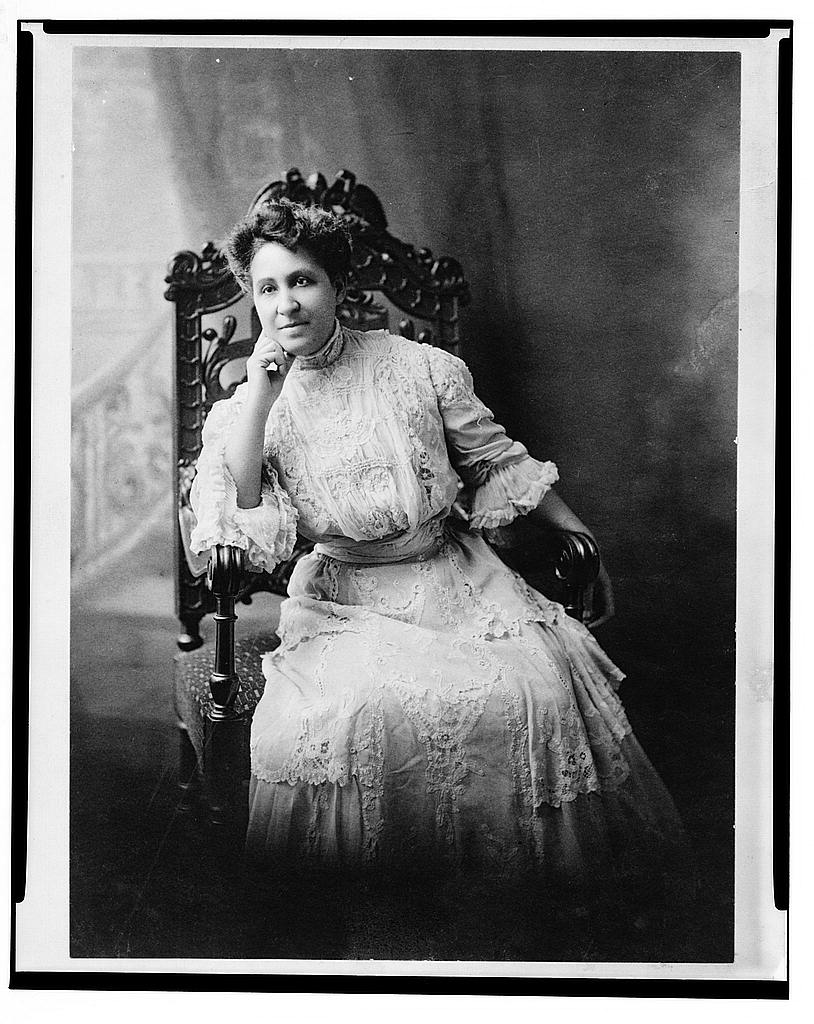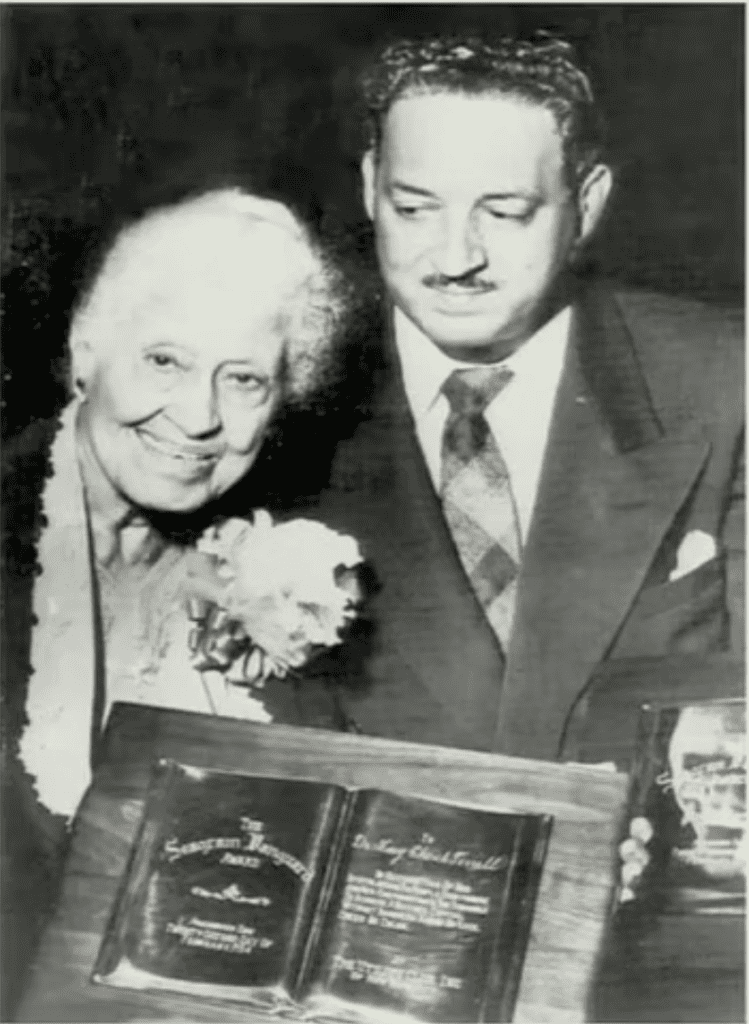D.C. Black History Spotlight: Mary Church Terrell (1863-1954)
By • February 8, 2023 0 3665

While browsing the Peabody Room of the Georgetown Neighborhood Library in search of a fitting subject for Black History Month, I came upon an intriguing 1906 local news report which led me down a research rabbit hole. Soon, I was happy to make the acquaintance of a truly remarkable and inspiring figure – Mary Church Terrell (1863-1954) – a D.C. teacher, national civil rights and women’s rights activist, and the individual leader perhaps more responsible than any other for the desegregation of the District’s restaurants in 1953.
Without Church Terrell, the District likely would not have created Douglass Day, celebrated to honor the birthday of abolitionist Frederick Douglass on Valentine’s Day. And without Douglass Day, and Abraham Lincoln’s birthday on February 12, Black History Month might never have been created for the month of February.
“St. Valentine shared honors yesterday with Frederick Douglass, the negro leader and education champion, whose birthday was February 14,” the Washington Post story from Feb. 15, 1906 began. “At all the colored schools of the city, exercises commemorating Douglass day were observed from 1 to 3 p.m. At the M Street High School, Oswald Garrison Villard, grandson of William Lloyd Garrison, the notable New York editor and Judge Robert H. Terrell delivered addresses paying tribute to the memory of Douglass and calling attention to the advancement of education since his death in 1895… Soon after the death of Frederick Douglass, negro teachers of Washington held a meeting and passed resolutions asking the board of education to appoint a Douglass Day. February 14 was chosen, and it has been observed each year since.”
So far, no mention of Mary Church Terrell. However, her husband, Judge Robert H. Terrell was noted as giving the address to honor Douglass.
When I looked up Douglass Day at douglassday.org, however, I found that credit for the day’s creation – still honored today — is given to Mrs. Mary Church Terrell, a teacher of Latin at the M Street School: “In Washington, D.C., a group led by Mary Church Terrell, (an important African American activist, educator, and author) observed Douglass’s birthday every February 14th as “Douglass Day.” And the site offers definitive proof of her founding role from the Library of Congress’s website at: www.loc.gov/item/mss425490606/.
Delving into Mary Church Terrell’s biography, I was swept up by her life story, a great American saga of an historical figure’s lifetime of fighting for civil and human rights by using her education to help others rise above oppression.
In the year of the Emancipation Proclamation, 1863, during the Civil War, Mary Church Terrell was born enslaved (for the first two years of her life) to mixed-race parents in Memphis, Tennessee. As a young girl, Mary soon learned the horrors of Jim Crow in the Reconstruction Era. Her father, businessman Robert Church, became one of the first African-American millionaires in the south. But, perhaps due to his outsized success as a mixed-race former slave, he was shot in the head. Though he survived, he suffered severely and his marriage grew strained, ending in divorce in the 1870s.
When her childhood friend Thomas Moss, an African-American businessman like her father, was killed by a White lynch mob in 1892, Church Terrell joined with her journalist friend Ida B. Wells to begin a life-long campaign to enact anti-lynching laws.

Following the lynching of her childhood friend Thomas Moss in 1892, Mary Church Terrell and her journalist friend Ida B. Wells, pictured here, dedicated themselves to writing and speaking out for anti-lynching laws. Ida B. Wells circa 1895. Wikipedia.
Church Terrell harnessed her advanced education and the privileges she had amassed as a light-skinned, wealthy African-American to dedicate her life to helping uplift others.
As one of the first African-American women in the United States to earn both a bachelor’s and master’s degree, Church Terrell graduated in 1888 from Oberlin College concentrating in Classical Languages. She was soon offered a professorship teaching Latin at Wilburforce University in Ohio.
Fearing that she might become too educated to be “marriable,” however, Church Terrell’s father dispatched her to Europe for a two-year finishing experience. In those years she learned to speak Italian, German and French (keeping diaries in various languages) and met notable women’s rights activists such as Susan B. Anthony.
Upon return in 1890, Church Terrell moved to Washington, D.C. where she began teaching Latin and Greek at one of the first public high schools for African-Americans, the M Street School at 128 M St. NW. Soon after joining the faculty, she married the chair of the Language Department, Harvard-educated African-American Robert H. Terrell. “I enjoyed assisting him in the Latin department so much, I made up my mind to assist him in all departments for the rest of my natural life,” Church Terrell wrote.

In 1906, Mary Church Terrell began teaching at the M Street (Colored ) High School, today’s Paul Lawrence Dunbar High School. Wikipedia photo, scanned from a public postcard.
Instead of settling into married life as a “woman of leisure” as was expected by her father, she turned her talents to writing and speaking out on the causes she cared most deeply about: anti-lynching, women’s suffrage, desegregation of Jim Crow establishments, improved education for African-Americans, abolishing the death penalty for Black victims of assault engaging in self-defense, maternal healthcare, boycotts of discriminatory businesses, ending the convict-lease system and the exploitation of Black sharecroppers, and many more.
“At first [Church Terrell] thinks about removing herself from public life, because she had gotten married, which was an expectation for a lot of women at that time. So for her to really galvanize around the pressing issues of the day and become a force in the founding of numerous organizations and campaigns that would ultimately reshape American history is quite phenomenal,” said Treva B. Lindsey, Professor of Women’s & Gender Studies, Ohio State University (PBS, American Masters, Unsung Women Who Changed America.)
Church Terrell soon gained the reputation as “the female Booker T. Washington” on the Chautauqua lecture circuit. She began one blistering pamphlet promoting a speech: “For the Good of America: Do you know that the United States is the only land on Earth where human beings are burned at the stake? In four years, 1918-1921, twenty-eight people were publicly burned by American mobs; 3436 people lynched…”
In 1892, Church Terrell co-founded the Colored Women’s League to address social problems facing the Black community. In 1895, she became one of the first African-American women appointed to a school board in the country where she advocated for equal access to education in Washington, D.C. for over a decade. “More than once my heart was saddened when some pupil would say ‘education will do us no good.’ There is nothing for colored people to do except for old menial positions and we don’t need an education for that,” she wrote (PBS, American Masters).
In 1896, just months after the U.S. Supreme Court upheld Jim Crow racial segregation in Plessy vs. Ferguson, Church Terrell co-founded the National Association of Colored Women (NACW). Calling for Black uplift and an end to segregation, the group served as an umbrella organization for the many Black women’s clubs around the country. As the first president of NACW, Church Terrell coined the motto, “Lifting as We Climb” to promote the idea that educated Black women could help African-Americans suffering from the stereotypes and discriminatory laws of the Jim Crow era to fulfill their true potentials.
According to the Library of Congress, Church Terrell spoke at the 1904 International Congress of Women in Berlin and was the only American to give her address in German.
She fought to include African-American women fully in the national women’s suffrage rights movement, picketing the White House repeatedly. The White-led National Women’s Party, however, insisted on remaining racially segregated.
In 1909, Church Terrell – at the behest of W.E.B. Dubois – became a charter member of the National Association for the Advancement of Colored People (NAACP). She traveled the country indefatigably to speak out for civil rights and women’s rights. In 1922, she organized the Silent March to pressure Congress to pass anti-lynching legislation. She continued to picket and boycott local establishments under the banner, “Don’t Buy Where You Can’t Work.” In 1949, after she sued over discrimination, she became the first African-American admitted to the Washington chapter of the American Association of University Women (AAUW).

At the behest of W.E.B. Du Bois, the first African-American PhD from Harvard University, Mary Church Terrell, the first African-American women to earn a master’s degree from Oberlin College, became a charter member of the NAACP in 1909. Wikipedia photo, 1907.
Church Terrell continued to organize and lead protests and sit-ins well into her late 80s. After being denied entry three times due to her mixed-race at a popular downtown restaurant in Washington, D.C. – Thomson’s Restaurant at 725 14th Street NW – she filed an anti-discrimination lawsuit that rose to the U.S. Supreme Court. A year before her death in 1954 – the same year the court ruled to desegregate U.S. public schools in Brown vs. Board of Education – the court ruled in the case of District of Columbia vs. John R. Thompson Co., Inc. to desegregate all restaurants and stores in Washington, D.C. The high court would soon hold such discrimination unconstitutional throughout the nation.

Mary Church Terrell with Justice Thurgood Marshall. Library of Congress.
Though Church Terrell published a memoir in 1940, “A Colored Woman in a White World,” only one full-length biography has ever been written about her. In 2020, Alison M. Parker, Chair of History at University of Delaware published “Unceasing Militant: The Life of Mary Church Terrell.” In a Dec. 17, 2020 interview with history professor Nikki Brown of University of Kentucky, Parker described Church Terrell as “one of the forerunners of intersectionalism… [who] always said there was a double burden” on Black women who suffered prejudice and discrimination based on both their race and their gender. (YouTube, “Unceasing Militant: The Life of Mary Church Terrell with Alison M. Parker).

In 1974, Mary Church Terrell’s home at 326 T St. NW, in Washington, D.C. was named a National Historic Landmark. Library of Congress.
Following her death in 1954, the famous African-American actor and Renaissance man Paul Robeson eulogized Church Terrell, calling her, “an unceasing militant struggling for the full citizenship of her people.” Parker found that description accurate. “She was unceasing and she never stopped. She never gave up hope.”
In 1974, Mary Church Terrell’s home at 326 T St NW, in Washington, D.C. was named a National Historic Landmark.

